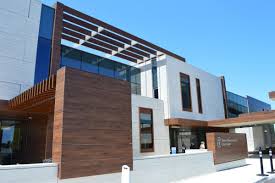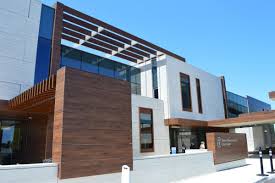Factors to Consider When Choosing Exterior Cladding
1.Resistance to Elements
HPL (High-Pressure Laminate) exterior cladding is a popular choice for its durability and resistance to the elements. Here are some ways that HPL exterior cladding is resistant to different elements:
-
Moisture: HPL cladding is highly resistant to moisture, making it ideal for areas with high humidity or rainfall. This is due to the material's non-porous surface, which prevents water from penetrating the cladding.
-
UV rays: HPL cladding is also highly resistant to UV rays, which can cause fading and discoloration over time. The material's surface is designed to resist sun damage and maintain its color and appearance for years.
-
Impact: HPL cladding is impact-resistant, making it a good choice for areas with strong winds or potential for hail damage. The material's dense and hard surface can withstand impacts and resist damage.
-
Fire: HPL cladding has excellent fire resistance, as it is made from fire-retardant materials. This makes it a safe and reliable choice for buildings that require high levels of fire protection.
-
Temperature fluctuations: HPL cladding is resistant to temperature fluctuations, making it ideal for areas with extreme weather conditions. It can withstand both high and low temperatures without warping, cracking, or deteriorating.
2.Insulation Property
HPL (High-Pressure Laminate) exterior cladding can provide some insulation properties to a building, although it's not typically used as the primary insulation material. HPL cladding is a relatively thin material, typically ranging from 6-15mm in thickness, which means it offers limited insulation value. However, there are some ways that HPL cladding can contribute to a building's overall insulation:
-
Reflective properties: HPL cladding can reflect heat from the sun, which can help reduce the amount of heat absorbed into a building's interior. This can help lower cooling costs and reduce the building's overall energy consumption.
-
Air barrier: When installed properly, HPL cladding can create an air barrier that helps prevent air leakage and reduce heat loss through the building envelope. This can help improve the building's overall energy efficiency.
-
Thermal bridging: HPL cladding can help reduce thermal bridging, which is the transfer of heat through a building's structure. The cladding can act as a barrier between the interior and exterior of the building, preventing heat transfer and improving insulation.
-
Insulated panels: Some manufacturers offer HPL cladding with insulated panels, which can provide additional insulation value. These panels typically feature a layer of insulation sandwiched between two layers of HPL, which can improve the cladding's overall insulation properties.
3.Expected Service Life
HPL (High-Pressure Laminate) exterior cladding has a long expected service life due to its durable and weather-resistant properties. The exact lifespan of HPL cladding can vary depending on a variety of factors, including the quality of the material, the installation process, and the environmental conditions where the building is located.
In general, HPL cladding has an expected service life of 20-50 years or more, depending on the specific product and manufacturer. Some high-quality HPL products have been known to last for up to 50 years or more, with proper maintenance and care.
Factors that can affect the lifespan of HPL cladding include:
-
Quality of the material: HPL cladding made from high-quality materials is likely to last longer than lower-quality materials.
-
Installation process: Proper installation is essential to ensure the cladding performs as intended and lasts as long as possible.
-
Environmental conditions: The amount of exposure to sunlight, wind, and rain can affect the lifespan of HPL cladding. Cladding installed in areas with harsh weather conditions may not last as long as cladding installed in more moderate environments.
-
Maintenance: Regular cleaning and maintenance can help extend the lifespan of HPL cladding and prevent damage from occurring.
Overall, HPL exterior cladding is a durable and long-lasting material that can provide reliable protection for buildings for decades. With proper installation, maintenance, and care, building owners can expect their HPL cladding to provide many years of service.
4. Cost-Effectiveness
HPL (High-Pressure Laminate) exterior cladding is considered a cost-effective solution for building exteriors due to its durability, longevity, and low maintenance requirements. While the initial cost of HPL cladding may be higher than some other cladding materials, the long-term benefits often outweigh the initial investment.
5. Ease of Maintenance
HPL (High-Pressure Laminate) exterior cladding is known for its low maintenance requirements, making it a popular choice for building exteriors. Here are some maintenance tips to keep HPL cladding in good condition:
-
Regular cleaning: HPL cladding should be cleaned regularly to remove any dirt or debris that may accumulate on the surface. Cleaning can be done using a mild detergent and a soft-bristled brush or cloth. Harsh cleaners or abrasive materials should be avoided, as they can damage the surface of the cladding.
-
Stain removal: If stains do occur, they should be addressed as soon as possible to prevent them from setting in. Most stains can be removed using a mild detergent and a soft-bristled brush or cloth. For tougher stains, specialized cleaners may be required. It's important to follow the manufacturer's instructions when using any cleaning product on HPL cladding.
-
Inspect for damage: HPL cladding should be inspected regularly for any signs of damage, such as cracks, chips, or peeling. If damage is found, it should be repaired as soon as possible to prevent further damage from occurring.
-
Avoid pressure washing: While HPL cladding is durable, it's important to avoid using a pressure washer to clean it, as the high-pressure water can damage the surface of the cladding.
-
Check sealant and joints: If the cladding has sealant or joints, these should be checked regularly for any signs of damage or wear. Damaged sealant or joints can allow moisture to seep in behind the cladding, which can cause damage to the underlying structure.
By following these maintenance tips, HPL cladding can remain in good condition and provide reliable protection for building exteriors for many years.

